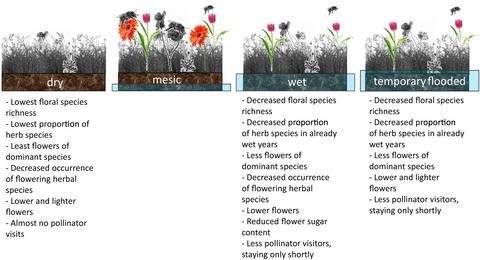Our official English website, www.x-mol.net, welcomes your
feedback! (Note: you will need to create a separate account there.)
Dryness, wetness and temporary flooding reduce floral resources of plant communities with adverse consequences for pollinator attraction
Journal of Ecology ( IF 5.3 ) Pub Date : 2020-01-28 , DOI: 10.1111/1365-2745.13364 Julia Walter 1
中文翻译:

干燥,潮湿和暂时性洪水会减少植物群落的花木资源,从而对授粉媒介吸引力产生不利影响
更新日期:2020-01-28
Journal of Ecology ( IF 5.3 ) Pub Date : 2020-01-28 , DOI: 10.1111/1365-2745.13364 Julia Walter 1
Affiliation

|
- Climate change alters precipitation regimes world‐wide and is regarded as a major threat for pollinators and pollination services. Yet, not much is known on how wetter as well as drier conditions affect food resources for pollinators and pollinator attraction in a multi‐species community context. It is unclear how community shifts under changed hydrological conditions might affect pollinators.
- This mesocosm study addresses existing research gaps by investigating effects of drought, wetness and temporary flooding on floral resources and pollinator attraction within a plant community, initially including nine insect‐pollinated and six wind‐pollinated species. Floral resources were assessed over three growing seasons. I monitored community descriptors (percentage of herbs and herbaceous species richness, presence of flowering insect‐pollinated individuals), floral traits (flower height, size and weight, floral sugar content of one key species) and proxies for plant fitness (pollinator attraction, seed and flower weight of one key species).
- Wetness and especially dryness decreased the species richness and biomass proportion of insect‐pollinated herbaceous species and flowering herbaceous plant individuals occurred less frequently. Permanent wetness decreased the floral sugar content of the key species Trifolium pratense . Wet, temporary flooded and especially dry communities were visited by pollinators less often. Active pollinators spent less time within wet and flooded communities, while not at all visiting dry communities. Seed and flower weight of the obligate xenogamous T. pratense in flooded and dry communities decreased, indicating negative consequences for plant fitness caused by a lack of pollination.
- Synthesis . While dryness had negative effects for floral resources both in terms of community descriptors and floral traits, negative effects of wetness and temporary flooding were mostly caused by a decrease of insect‐pollinated herbaceous species. The study thus indicates that shifts in plant community composition are decisive for a predictive understanding of plant–pollinator interactions under environmental change, but these have been neglected in past research. Changing precipitation patterns will adversely affect floral resources and pollinator attraction in agriculturally used temperate grassland, which might have widespread negative consequences for pollination services and food security in the coming decades.
中文翻译:

干燥,潮湿和暂时性洪水会减少植物群落的花木资源,从而对授粉媒介吸引力产生不利影响
- 气候变化改变了全世界的降水状况,被认为是授粉媒介和授粉服务的主要威胁。然而,关于多物种社区环境中潮湿和干燥条件如何影响传粉媒介和传粉媒介吸引力的粮食资源知之甚少。目前尚不清楚在变化的水文条件下社区转移如何影响授粉媒介。
- 这项中观研究通过调查干旱,潮湿和临时洪水对植物群落内花卉资源和授粉媒介吸引力的影响,解决了现有的研究空白,最初包括9种昆虫授粉和6种风媒授粉物种。在三个生长季节评估了花卉资源。我监测了群落描述(草本和草本物种丰富程度,开花的昆虫授粉个体的存在),花卉特征(花卉高度,大小和重量,一种关键物种的花卉糖含量)和植物适应性的代表(授粉媒介,种子)和一种重要物种的花重)。
- 潮湿,特别是干燥会降低昆虫授粉的草本物种的物种丰富度和生物量比例,开花的草本植物个体发生的频率降低。长期湿润会降低关键物种白三叶的花糖含量。授粉者很少访问湿的,临时的洪水社区,特别是干旱的社区。活跃的传粉者在潮湿和水淹的社区中花费的时间更少,而在所有干燥的社区中却没有。水淹和干旱社区中专性异生T. pratense的种子和花朵重量减少,这表明由于缺乏授粉对植物适应性产生了负面影响。
- 综合。虽然干旱对群落特征和花卉性状都对花卉资源有负面影响,但潮湿和暂时性洪水的负面影响主要是由昆虫授粉的草本物种减少引起的。因此,该研究表明,植物群落组成的变化对于环境变化下植物与传粉媒介相互作用的预测性理解具有决定性作用,但这些在过去的研究中已被忽略。降雨模式的变化将对农业用温带草原的花卉资源和授粉媒介吸引力产生不利影响,这可能在未来几十年中对授粉服务和粮食安全产生广泛的负面影响。











































 京公网安备 11010802027423号
京公网安备 11010802027423号